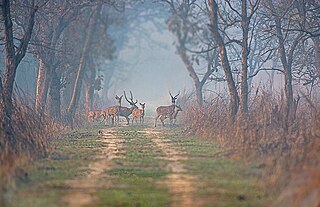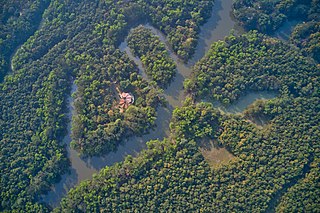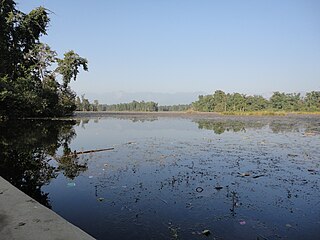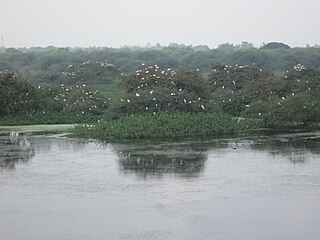Related Research Articles

Kolleru Lake is one of the largest freshwater lakes in India located in state of Andhra Pradesh and forms the largest shallow freshwater lake in Asia. 15 kilometers away from the Eluru and 65 km from Rajamahendravaram, the lake is located between the Krishna and Godavari deltas. Kolleru Lake is located in Eluru district. The lake is fed directly by water from the seasonal Budameru and Tammileru streams, and is connected to the Krishna and Godavari irrigation systems by over 67 major and minor irrigation canals. This lake is a major tourist attraction. Many birds migrate here in winter, such as Siberian crane, ibis, and painted storks. The lake was an important habitat for an estimated 20 million resident and migratory birds, including the grey or spot-billed pelican. The lake was declared as a wildlife sanctuary in November 1999 under India's Wildlife Protection Act of 1972, and designated a wetland of international importance in November 2002 under the international Ramsar Convention. The wildlife sanctuary covers an area of 308 km2.

Sultanpur National Park (formerly Sultanpur Bird Sanctuary) is located at Sultanpur village on Gurugram-Jhajjar highway, 15 km from Gurugram, Haryana and 50 km from Delhi in India. This covers approximately 142.52 hectares.

Dudhwa National Park is a national park in the Terai belt of marshy grasslands in northern Uttar Pradesh, India. It stretches over an area of 490.3 km2 (189.3 sq mi), with a buffer zone of 190 km2 (73 sq mi). It is part of the Dudhwa Tiger Reserve in the Kheri and Lakhimpur districts. The park is located on the Indo-Nepali border in the Lakhimpur Kheri District.

Nal Sarovar Bird Sanctuary, consisting primarily of a 120.82-square-kilometre (46.65 sq mi) lake and ambient marshes, is situated about 64 km to the west of Ahmedabad near Sanand Village, in the Indian state of Gujarat. Mainly inhabited by migratory birds in winter and spring, it is the largest wetland bird sanctuary in Gujarat, and one of the largest in India. It was declared a bird sanctuary in April 1969.

The Lower Gangetic Plains moist deciduous forests is a tropical and subtropical moist broadleaf forests ecoregion of Bangladesh and India. The ecoregion covers an area of 254,100 square kilometres (98,100 sq mi), comprising most of Bangladesh and the Indian states of West Bengal, Bihar and Tripura, and extending into adjacent states of Odisha, Uttar Pradesh and a tiny part of Assam, as well as adjacent western Myanmar.

Nawabganj Bird Sanctuary, renamed in 2015 Shahid Chandra Shekhar Azad Bird Sanctuary, is a bird sanctuary located in Unnao district on the Kanpur-Lucknow highway in Uttar Pradesh, India consisting of a lake and the surrounding environment. It is one of the many wetlands of Northern India. The sanctuary provides protection for 250 species of migratory birds mostly from CIS countries, but the numbers have been dwindling since the 1990s, most having relocated to newer areas in Himachal and Rajasthan. The sanctuary also houses a deer park, watchtowers and boats.

Raiganj Wildlife Sanctuary is situated near Raiganj in Uttar Dinajpur district in the Indian state of West Bengal. The bird sanctuary is home to 164 species of birds, and some 90,000 to 100,000 migratory birds visit the sanctuary every year. As per the MEE report, West Bengal''s Jaldapara national park and Raiganj wildlife sanctuary, Himachal Pradesh''s Sainj and Tirthan wildlife sanctuaries as well as the Great Himalayan national park have been declared as top five national parks and wildlife sanctuaries in India.
Sandi Bird Sanctuary is a bird sanctuary in Hardoi district of Uttar Pradesh, India.

The Ratapani Tiger Reserve, located in the Raisen district of Madhya Pradesh, in Vindhya Range in central India, is one of the finest teak forests in the state and is less than 50 kilometres (31 mi) away from the capital Bhopal.
Kanjirankulam Bird Sanctuary is a 1.04 km2 (0.40 sq mi) Protected area near Mudukulathur Ramanathapuram District, Tamil Nadu. India, declared in 1989. 9°20′N78°29′E. It is adjacent to Chitrangudi Bird Sanctuary. It is notable as a nesting site for several migratory heron species that roost in the prominent growth of babul trees there. International name: Chitragudi and Kanjirankulam Bird Sanctuary, IBA Code: IN261, Criteria: A1, A4i. The sanctuary has been designated as a protected Ramsar site since 2022.
Sur Sarovar, often referred to as Keetham Lake, is a picturesque lake off the Agra-Delhi national highway (NH-19). The Agra Bear Rescue Facility, a facility for saving Sloth bears dedicated to rehabilitating previously captured "dancing bears," is located next to it. Since 2020, the lake has been recognized as a Ramsar site that is protected.

The Chandra Prabha Wildlife Sanctuary, also known as Chandraprabha, is situated in Chandauli district of Uttar Pradesh state in central India. It is well endowed with beautiful picnic spots, dense forests, and scenic waterfalls like Rajdari, Devdari & Naugarh waterfall that attract tourists every year to its vicinity. Chandra Prabha Wildlife Sanctuary is situated about 70 kilometres from the historic city of Varanasi.
Saman Bird Sanctuary is a wetland in Mainpuri district, in western Uttar Pradesh. Located in the village of Saman, it has been designated as a protected Ramsar site since 2019.

The Kanwar Taal or Kabar Taal Lake or Kabartal Wetland located in Begusarai district of Bihar, India, is Asia's largest freshwater oxbow lake. It is approximately six times the size of the Bharatpur Sanctuary. In November 2020, the Ministry of Environment, Forest and Climate Change (MoEFCC) declared it the first Ramsar site in Bihar. There are a total of 80 Ramsar Sites in India till 2024.
Kanwar jheel, as it is locally called, is located 22 km north-west of Begusarai Town in Manjhaul. It is a residual oxbow lake, formed due to meandering of Burhi Gandak river, a tributary of Ganga, in the geological past. It covers 2,620 hectares of the Indo-Gangetic plains in the northern Bihar State. The Site is one of 18 wetlands within an extensive floodplain complex; it floods during the monsoon season to a depth of 1.5 metres. This absorption of floodwaters is a vital service in Bihar State where 70% of the land is vulnerable to inundation. During the dry season, areas of marshland dry out and are used for agriculture. Significant biodiversity is present, with 165 plant species and 394 animal species recorded, including 221 bird species. The Wetland is an important stopover along the Central Asian Flyway, with 58 migratory waterbirds using it to rest and refuel. It is also a valuable site for fish biodiversity with over 50 species documented. Five critically endangered species inhabit the site, including three vultures – the red-headed vulture, white-rumped vulture and Indian vulture – and two waterbirds, the sociable lapwing and Baer’s pochard. Major threats to the Site include water management activities such as drainage, water abstraction, damming and canalization.

Ghodaghodi Tal is a Ramsar site in western Nepal. It was established in August 2003 it covers an area of 2,563 h (9,230 ks) in Kailali District at an elevation of 205 m (673 ft) on the lower slopes of the Siwalik Hills. It was declared as a bird sanctuary in March 2022.

Vaduvoor Bird Sanctuary is a 128.10-hectare area located in Vaduvoor lake, Mannargudi Taluk, Thiruvarur District, Tamil Nadu, India. The sanctuary is about 25 kilometers from Thanjavur and 14 kilometers from Mannargudi on the Thanjavur-Kodiakkarai State Highway 63. It was created in the year 1999. The irrigation tank receives water from November to April every year which attracts numerous foreign birds from Europe and America. The sanctuary attracts more than 40 species of water birds like the white ibis, painted stork, grey pelican, pintails, cormorants, teals, herons, spoonbills, darters, coots, Open bill storks, and pheasant–tailed jacana. The sanctuary is a favorite spot for the migratory birds and during the months of November and December more than 20000 winged visitors reach this area. The sanctuary has basic facilities for tourists to stay overnight and enjoy watching the birds from the two watch towers.

Khijadiya Bird Sanctuary is a bird sanctuary located in Jamnagar district of Gujarat, India. About 300 species of migratory birds have been recorded here.
Udaypur Wildlife Sanctuary is a wildlife sanctuary located in West Champaran district of Bihar state, India. It was established in 1978, and covers an area of 8.74 km2.
Saman is a large village in Kishni block of Mainpuri district, Uttar Pradesh. It is the site of the Saman Bird Sanctuary, a large wetland area designated as a protected Ramsar site since 2019. The village lands occupy a large area, and there are many distinct hamlets counted as part of its administrative jurisdiction. As of 2011, Saman had a total population of 14,522, in 2,382 households.
References
- 1 2 "Parvati Arga Bird Sanctuary". Ramsar Sites Information Service. Retrieved 3 February 2020.
- ↑ Khanna, K. K. "Phytodiversity (pteridophytes and angiosperms) of Parvati Arga Bird Sanctuary, Gonda District, Uttar Pradesh, India". Geophytology 45(2): November 2015. pp. 239-244
- ↑ "Upper Gangetic Plains Moist Deciduous Forests". World Wildlife Fund. Accessed 22 November 2017
- ↑ Khanna, K. K. "Phytodiversity (pteridophytes and angiosperms) of Parvati Arga Bird Sanctuary, Gonda District, Uttar Pradesh, India". Geophytology 45(2): November 2015. pp. 239-244